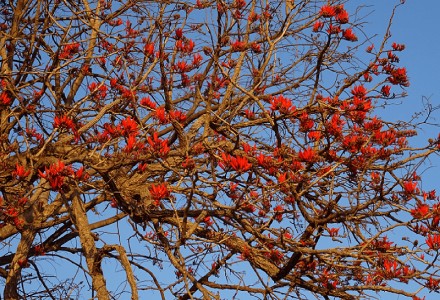
Bombax Facts
- The rather lovely Bombax forms a rather impressive genus of primarily tropical trees. All of these exist within the mallow family.
- Currently, experts recognize a total of 5 species within this beautiful genus. Without a doubt, the best-known member of the genus is the visually remarkable B.ceiba.
- The various species also remain known by several common names. Some of these general names include simal, red cotton tree, and kapok.
- This fascinating and rather popular variety of tree also remains heavily cultivated in both tropical and subtropical regions of the world.
Related Articles
Carolina Silverbell Kauri Tree Rainbow Eucalyptus
Bombax Physical Description
The various varieties of Bombax also comprise some of the largest tree species within their respective ranges.
Some species attain rather great heights, sometimes as much as 131 ft (40 m). Consequently, the trunks of some varieties may have a diameter in excess of ten ft (3 m).
The Bombax also all have a deciduous nature. The leaves develop compound in form, palm-shaped, and also measure an average of approximately 20 in (50 cm) across.
Each stem produces 5-10 long red flowers. The seed husks remain covered by a fiber that bears a strong similarity to cotton and also serves as the inspiration for the common name.
- Kingdom: Plantae
- Phylum: Angiosperms
- Class: Eudicots
- Order: Malvales
- Family: Malvaceae
- Genus: Bombax
Photographer: Jan Smith
CC License: https://bit.ly/1ryPA8o
Bombax Distribution, Habitat, and Ecology
The beautiful and usually quite colorful Bombax evolved as endemic to a wide swathe of northern Australia, subtropical portions of East Asia and Southeast Asia, the Indian subcontinent, and western Africa.
In its natural environment, it most typically grows in areas of reasonably dense, tropical foliage. However, it has become rather popular as an ornamental tree and is used widely in parks and gardens.
Interestingly, blooming for this genus also occurs rather earlier than most trees, often occurring between January and March.
Several varieties of this genus are also used as food plants by the larvae of some Lepidoptera species including the leaf-miner, which feeds exclusively on several members of this genus.
Species Sharing Its Range
Indian Bullfrog Mycena Chlorophus Thorny Dragon
Check out our other articles on 10 Dazzling Denizens of the Depths, Texas Blind Salamander, Kings Canyon, White-Nosed Coati, Petra Iris, Hemlock Looper, Shoebill

